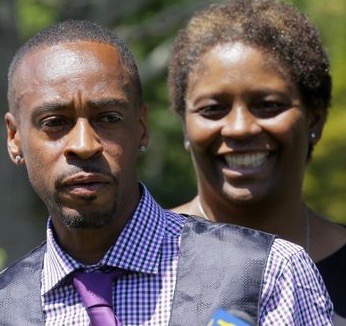 Dion Harrell and his aunt, Peggy Bennett (Photo by Tanya Breen/Asbury Park Press)
Three days later, she saw 22-year-old Dion Harrell in the parking lot of the McDonald’s and believed he was her attacker. Police picked up Harrell and brought him to a police station where Harrell protested his innocence. He pleaded with the police to take him to see the victim under the belief that if she saw him, she would realize her mistake. Although this was not typical procedure, the police finally relented and took Harrell into the room where the victim was and she confirmed her identification of him as the rapist.
Harrell was charged with second-degree sexual assault and third-degree theft. He went to trial in Monmouth County Circuit Court in May 1992.
The victim identified him as her attacker. A New Jersey State Police crime laboratory analyst testified that based on blood typing analysis, Harrell was among only 2 percent of the population who could not be eliminated as the source of the semen found in a rape kit. DNA testing was not available at that time in New Jersey.
Harrell testified and denied the attack. He said that on the night of the rape, he played basketball with a group of friends, including a police detective, and later rode his bicycle with a nephew to a friend’s house where he remained until he went home about 12:30 a.m. The detective testified that he had played basketball with Harrell on several occasions, but could not remember if he played with Harrell on the night of the rape. Harrell’s mother and sister testified that he came home from basketball, showered and went to his friend’s house with his nephew around 10:30. A woman testified she saw Harrell and his nephew riding their bikes and the friend testified that Harrell and the nephew were at his house until 12:30 a.m.
On May 19, 1992, the jury convicted Harrell of second-degree sexual assault and acquitted him of the theft charge. Harrell was sentenced to eight years in prison.
He was released on parole after four years in prison and was required to register as a sex offender. Over the next several years, he was twice convicted of failing to properly register and was sentenced to probation. He drifted in and out of homelessness and was unable to get and maintain a job because he was on the sex offender registry.
In 1997, while still in prison, Harrell wrote to the Innocence Project in New York requesting DNA testing. The Innocence Project, which has a backlog of more than 10,000 such requests, agreed to take on his case in 2013. An investigation of the case showed that the crime lab analyst’s testimony was erroneous. It was not the case that 98 percent of the male population could be eliminated as the source of the sample. In fact, none of the male population could be excluded, the evidence showed.
Dr. Joseph Warren, an expert in forensic biology, examined the laboratory reports and the trial transcript and concluded that the prosecution’s crime lab analyst had made “egregious misstatements of conventional serology and statistics” which were “contrary to scientific principles generally accepted at the time (and today).”
In November 2013, the Innocence Project sought the physical evidence in the case from the Monmouth County Prosecutor’s Office. Officials said the evidence no longer existed. However, in the fall of 2014, the Prosecutor’s Office said it had located slides made from the rape kit.
However, the prosecution opposed testing the evidence on the basis that state law only allowed testing if defendants were in custody. Attorney Vanessa Potkin, Director of Post-Conviction Litigation for the Innocence Project, argued that spending 20 years on a sex offender registry restricted his life made it fundamentally unfair to deny him evidence that could prove his innocence, and that long-established common law also provided an avenue for the court to order testing. Moreover, Potkin noted that the National District Attorney’s Association had adopted a policy that DNA testing should be performed in any case at any stage, even after all appeals had been exhausted, if the testing could determine innocence.
In February 2015, two weeks before a judge was to rule on the motion for testing, the Prosecutor’s Office agreed to allow the testing to be performed.
While the testing was being performed, the Innocence Project’s policy reform team worked to change the law in New Jersey. In November 2015, the state expanded the law to allow for DNA testing for defendants after their prison terms are over.
In July 2016, the DNA test results excluded Harrell as the rapist and the prosecution said it would ask that Harrell’s conviction be vacated.
On August 3, 2016, the conviction was vacated and the case was dismissed. The prosecution also requested that his two convictions for failing to register be vacated. That motion was granted and those charges also were dismissed.
In July 2018, Harrell filed a federal civil rights lawsuit seeking compensation for his wrongful conviction. In August 2018, Harrell filed a claim for compensation with the state of New Jersey. In June 2020, the claim was settled for $250,000.
In January 2021, Harrell passed away in Long Branch, New Jersey.
– Maurice Possley
|